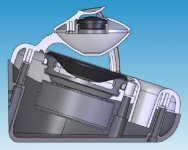I am very happy with my home speakers, but I've been working for the past few years to get some of that magic in my car. I've tried everything from tractrix horns to Unity waveguides, and everything in between. Recently I stumbled across a design which looks promising, so thought I'd document how to clone it.
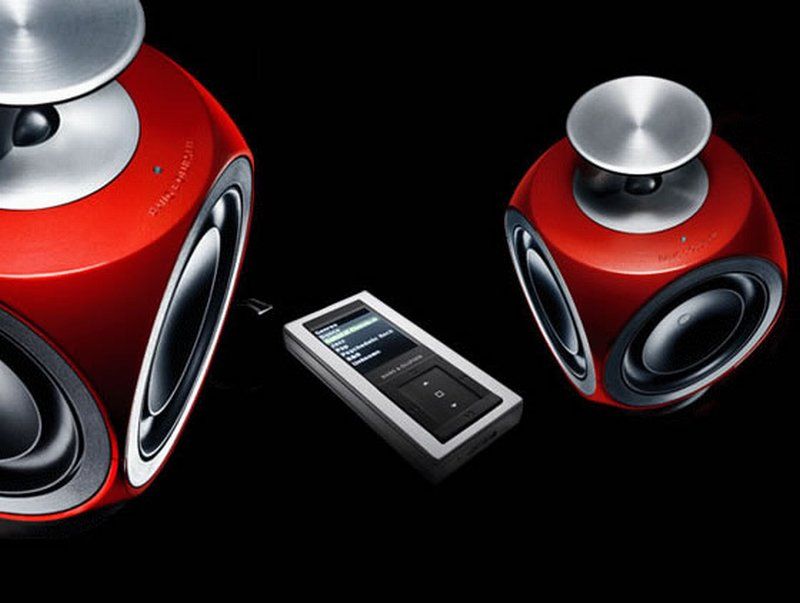
The speaker is a Beolab3. It uses an unusual enclosure shape to reduce diffraction, and an acoustic lens and waveguide to shape the polar response of the tweeter.

The speaker is a Beolab3. It uses an unusual enclosure shape to reduce diffraction, and an acoustic lens and waveguide to shape the polar response of the tweeter.
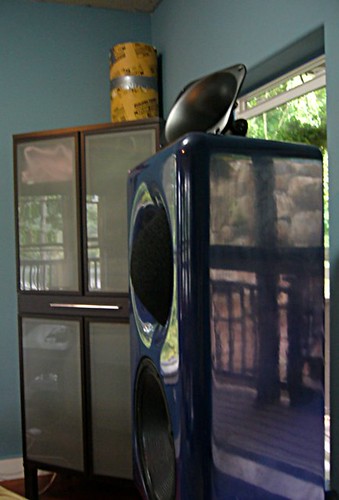
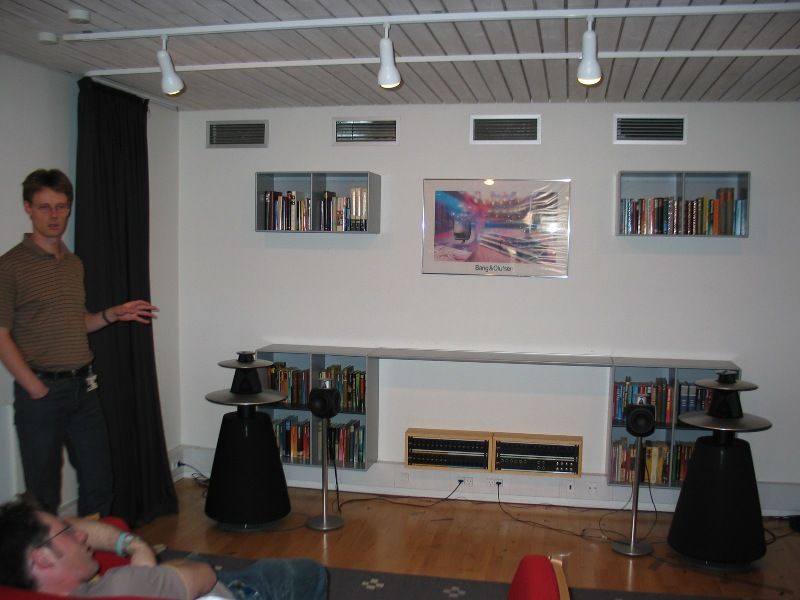
- Both are two ways
- Each uses a waveguide on the tweeter
- Both enclosures used curved surfaces to reduce diffraction
- Both designers focus on the power response over the frequency response
In my opinion, these are all excellent goals for a design.
Here's a quote from an article about the company:
"There was a lot of talk about the importance of the power response (the power response of a loudspeaker signifies the sound pressure averaged over all directions of radiation rather than just one - basically the combination of the on and off axis response in 3 dimensions ) over the frequency response. They believe that having a smooth power response is more important than a smooth frequency response for a speaker."
In a nutshell, I'm hoping that the Beolab 3 might give me a fraction of my home speaker's performance, but in a much MUCH smaller footprint.
Note that cost is no object here; I'm simply trying to reduce the size to a point where it will fit in my car.
The "secret sauce" in the B&O speaker is clearly the "Acoustic Lens Technology" (ALT) licensed from Sausalito Audio Works (SAW.)
After studying their patents, I have a fairly good grasp of how it works. But first, some background.
A conventional piston begins to "beam" at a frequency equivalent to it's diameter. For instance, we'd expect a 1" dome to "beam" above 13500hz. (speed of sound/diameter) In the graph above, we see that the "rule of thumb" is true. The dome measures flat on axis, but the response falls quickly off axis.
The reason why this is A Very Bad Thing is that a great deal of the sound that we hear is reflected, and the rolled off response off-axis contributes to the unnatural "hi-fi" sound endemic to conventional loudspeakers.
Waveguides have been discussed in-depth on this forum, and they're an excellent solution. In the graphs above, we can see that the on and the off-axis response of a waveguide is consistent. This helps to create a realistic soundstage, and reduce listening fatigue. Unfortunately, waveguides are BIG, and there's no getting around that.
Or is there?
From what I read in the patents, I believe the SAW acoustic lens is small because it works over a narrow bandwidth.
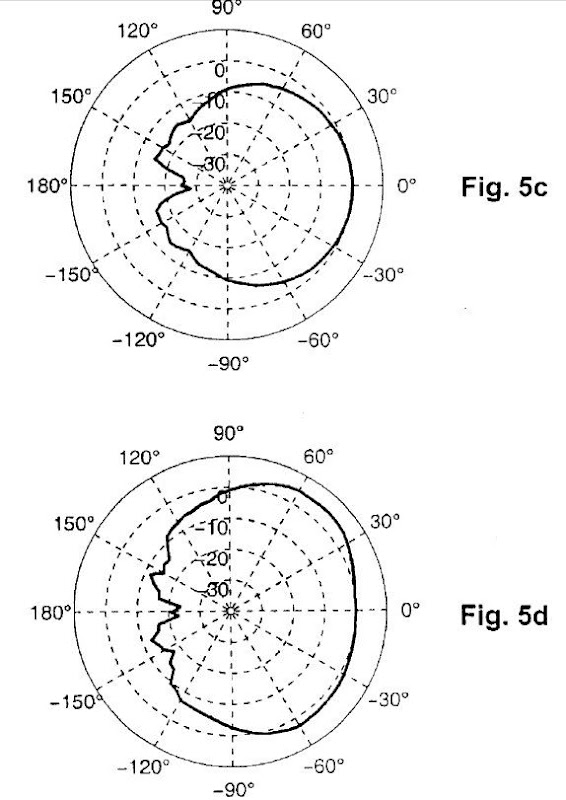 The measurements above show the polar response of the ALT device. The top pic is the response at 20khz, and the 2nd is at 10khz. You can see that the response off-axis is stable out to 90 degrees.
The measurements above show the polar response of the ALT device. The top pic is the response at 20khz, and the 2nd is at 10khz. You can see that the response off-axis is stable out to 90 degrees.
On the other hand, the waveguide in my home speaker words down to 900hz. 900hz is 15" long, and that's why the waveguide is that big. From what I'm seeing in the SAW patents, their lens isn't working at all frequencies. It's basically tuned to work at frequencies where the piston is beaming.
For instance, the 1" Scan Speak tweeter is beaming from 14000 and up; therefore you only need a lens that works in that narrow range, just a fraction of an octave. In the rest of it's range, it's basicaly omnipolar, and no lens is needed.
That's why their lens/waveguide is so small.
After studying their patents, I have a fairly good grasp of how it works. But first, some background.
An externally hosted image should be here but it was not working when we last tested it.
An externally hosted image should be here but it was not working when we last tested it.
The reason why this is A Very Bad Thing is that a great deal of the sound that we hear is reflected, and the rolled off response off-axis contributes to the unnatural "hi-fi" sound endemic to conventional loudspeakers.
Waveguides have been discussed in-depth on this forum, and they're an excellent solution. In the graphs above, we can see that the on and the off-axis response of a waveguide is consistent. This helps to create a realistic soundstage, and reduce listening fatigue. Unfortunately, waveguides are BIG, and there's no getting around that.
Or is there?
From what I read in the patents, I believe the SAW acoustic lens is small because it works over a narrow bandwidth.

On the other hand, the waveguide in my home speaker words down to 900hz. 900hz is 15" long, and that's why the waveguide is that big. From what I'm seeing in the SAW patents, their lens isn't working at all frequencies. It's basically tuned to work at frequencies where the piston is beaming.
For instance, the 1" Scan Speak tweeter is beaming from 14000 and up; therefore you only need a lens that works in that narrow range, just a fraction of an octave. In the rest of it's range, it's basicaly omnipolar, and no lens is needed.
That's why their lens/waveguide is so small.
Patrick, how is the xt 1464 horn ? what compression driver do you have with it ?
I have a 1.4" ev dh7 on an ev hr90 horn (crossed at 1khz) and was thinking about trying that horn. Using 24db LR, I think 1khz crossover point should work (-6db at crossover point). Looking at the di for that xt horn, its freq response should drop off below 1500hz due to the height of the 12" mouth (but shown is 2khz knee). My hr90 has a 13.7" high mouth, it loses directivity below 1khz, thats where I cross it.
I've switched to the klipsch rb75 with 2khz crossover 90 x 60 degrees.
norman
I have a 1.4" ev dh7 on an ev hr90 horn (crossed at 1khz) and was thinking about trying that horn. Using 24db LR, I think 1khz crossover point should work (-6db at crossover point). Looking at the di for that xt horn, its freq response should drop off below 1500hz due to the height of the 12" mouth (but shown is 2khz knee). My hr90 has a 13.7" high mouth, it loses directivity below 1khz, thats where I cross it.
I've switched to the klipsch rb75 with 2khz crossover 90 x 60 degrees.
norman
The reason the waveguide is small is because it is not trying to constrain the radiation to a small angle like the waveguide on Earl's speakers. From what I can see it's a reflector that reflects high frequency sound omni-directionally but only over a given vertical angle (at least at high frequencies). The lows are obviously already omni, so it's just the highs that need to be reflected.
My two cents:
I've had my Alesis buyout dome tweeters in my home made plywood
S.A.W. lenses for a few years now.
Go for it.
Try the concept out with some modeling clay first, for proof, like I did.
Horn loaded (with the S.A.W. lens), the domes are much more efficient,
so plan to pad them down to match your mid/woof.
You're gonna love it!
I do.
-Steve
I've had my Alesis buyout dome tweeters in my home made plywood
S.A.W. lenses for a few years now.
Go for it.
Try the concept out with some modeling clay first, for proof, like I did.
Horn loaded (with the S.A.W. lens), the domes are much more efficient,
so plan to pad them down to match your mid/woof.
You're gonna love it!
I do.
-Steve
At first this ALT looked complicated to make, but on second look it's kinda easy. Start with a 3-1/2" ball, cut it in 1/2, cut it 1/2 again (think: 1/4 slice of watermelon), trim out a phase-plug-shaped opening (1-1/2" radius) for the tweeter, and then make the "visor" (using leftover material) using the same 1-1/2" radius.
The base of the phase-plug-shaped opening is only 3/4" with a slight relief at the base (1").
The base of the phase-plug-shaped opening is only 3/4" with a slight relief at the base (1").
An externally hosted image should be here but it was not working when we last tested it.
nice - do you have an estimate of its side view and ellipse crossection? look at Beovox 7-4 center speaker with a flat front lens
http://cdx.dexigner.com/article/5365/BeoLab_7_4___01.jpg
http://cdx.dexigner.com/article/5365/BeoLab_7_4___01.jpg
Dont want to spoil the fun, but theres alot of sharp corners in this design, especially the high frequency dispersion thing, so i dont see how it could be low diffraction. And above that, it looks like an omni device, which is said to be problematic in rooms.
EDIT: just realized you want to use it in a car. i dont know how omni designs work in a car, but as the boundaries are even closer, i think you will listen to alot of very early reflections with omni speakers.
EDIT: just realized you want to use it in a car. i dont know how omni designs work in a car, but as the boundaries are even closer, i think you will listen to alot of very early reflections with omni speakers.
Last edited:
I bought something similar last year - some company had designed this fancy gaming speaker system, but the company was folded for some reason, and they dumped their inventory. I got two working systems, pretty cheap, and they look to be about the same idea. The thing is called the Spherex Xbox 5.1, and was reviewed in the Audio Critic. I attached a diagram of one of the speakers.
The thing is basically an omni radiator, and I see the top 'lenses' as high frequency reflectors. The overall sound is fine - not superb, not bad.
Personally, I don't find omni radiators my preferred radiation pattern - I hear too much ambience, and not enough direct sound. I might add here that I've been using SLs Pluto speakers for a number of years (also omni radiation), and prefer dipole speakers.
I've been wanting to get a better system in my car sometime too. Some time back, I got a ride in a fancy Cadillac - it had pretty nice sound! It was a surround system, and in retrospect, it seems like that would be a great way to deal with such a small space, and such uneven distances between the speakers and the listener(s).
The thing is basically an omni radiator, and I see the top 'lenses' as high frequency reflectors. The overall sound is fine - not superb, not bad.
Personally, I don't find omni radiators my preferred radiation pattern - I hear too much ambience, and not enough direct sound. I might add here that I've been using SLs Pluto speakers for a number of years (also omni radiation), and prefer dipole speakers.
I've been wanting to get a better system in my car sometime too. Some time back, I got a ride in a fancy Cadillac - it had pretty nice sound! It was a surround system, and in retrospect, it seems like that would be a great way to deal with such a small space, and such uneven distances between the speakers and the listener(s).
Attachments
Good thread, I hope you make progress.
Eventually I want to try and build almost every 'type' of speaker, open baffle, full range, horn loaded electrostatics etc.......and have racked my brains as to how to do omni which seems to be the main focus of the B&O speakers.
I purchased these, from my now growing obsession with Ikea parts:

Was going to use them as is, with a tweeter firing up into it. Duevel Planets ish. The ones I have fit a standard tweeter inside, you could implement them like the image above.
I also considered casting the interior, and then carving out the phase plug shape. However distractions and other projects are stealing my priorities.
Good luck.
Eventually I want to try and build almost every 'type' of speaker, open baffle, full range, horn loaded electrostatics etc.......and have racked my brains as to how to do omni which seems to be the main focus of the B&O speakers.
I purchased these, from my now growing obsession with Ikea parts:

Was going to use them as is, with a tweeter firing up into it. Duevel Planets ish. The ones I have fit a standard tweeter inside, you could implement them like the image above.
I also considered casting the interior, and then carving out the phase plug shape. However distractions and other projects are stealing my priorities.
Good luck.
a few years ago I spent about 10 seconds to get a lens for an upfiring helper tweeter - there's a cavity and a slot involved
An externally hosted image should be here but it was not working when we last tested it.
I am very happy with my home speakers, but I've been working for the past few years to get some of that magic in my car. I've tried everything from tractrix horns to Unity waveguides, and everything in between. Recently I stumbled across a design which looks promising, so thought I'd document how to clone it.

The speaker is a Beolab3. It uses an unusual enclosure shape to reduce diffraction, and an acoustic lens and waveguide to shape the polar response of the tweeter.
PB...do you feel that you have taken the waveguide as far as you want to take it? What are the unity waveguide limitations that have led you into this new direction?
And where can I find a primer on the principles at work in the Beolab speaker?
Do you believe that the acoustic lens will be OK in the mobile environment? (well I guess Aston Martin does.)
- Status
- This old topic is closed. If you want to reopen this topic, contact a moderator using the "Report Post" button.
- Home
- Loudspeakers
- Multi-Way
- Cloning a $3200 Speaker for $400

